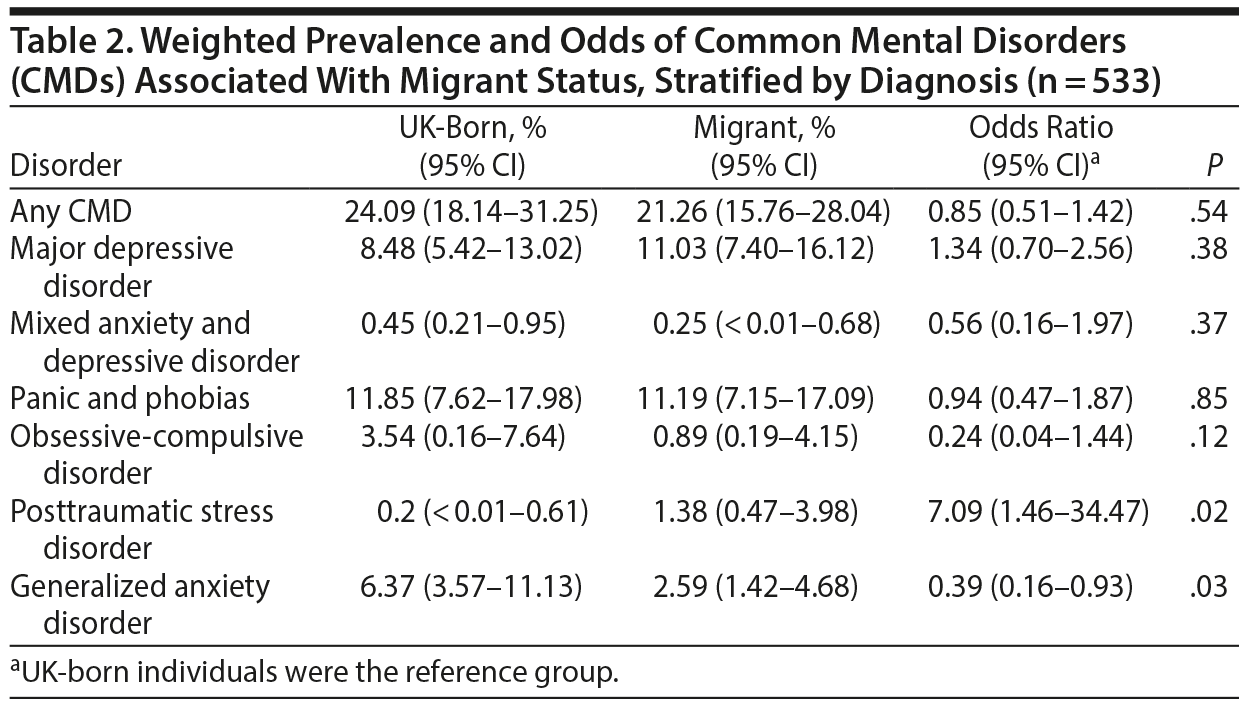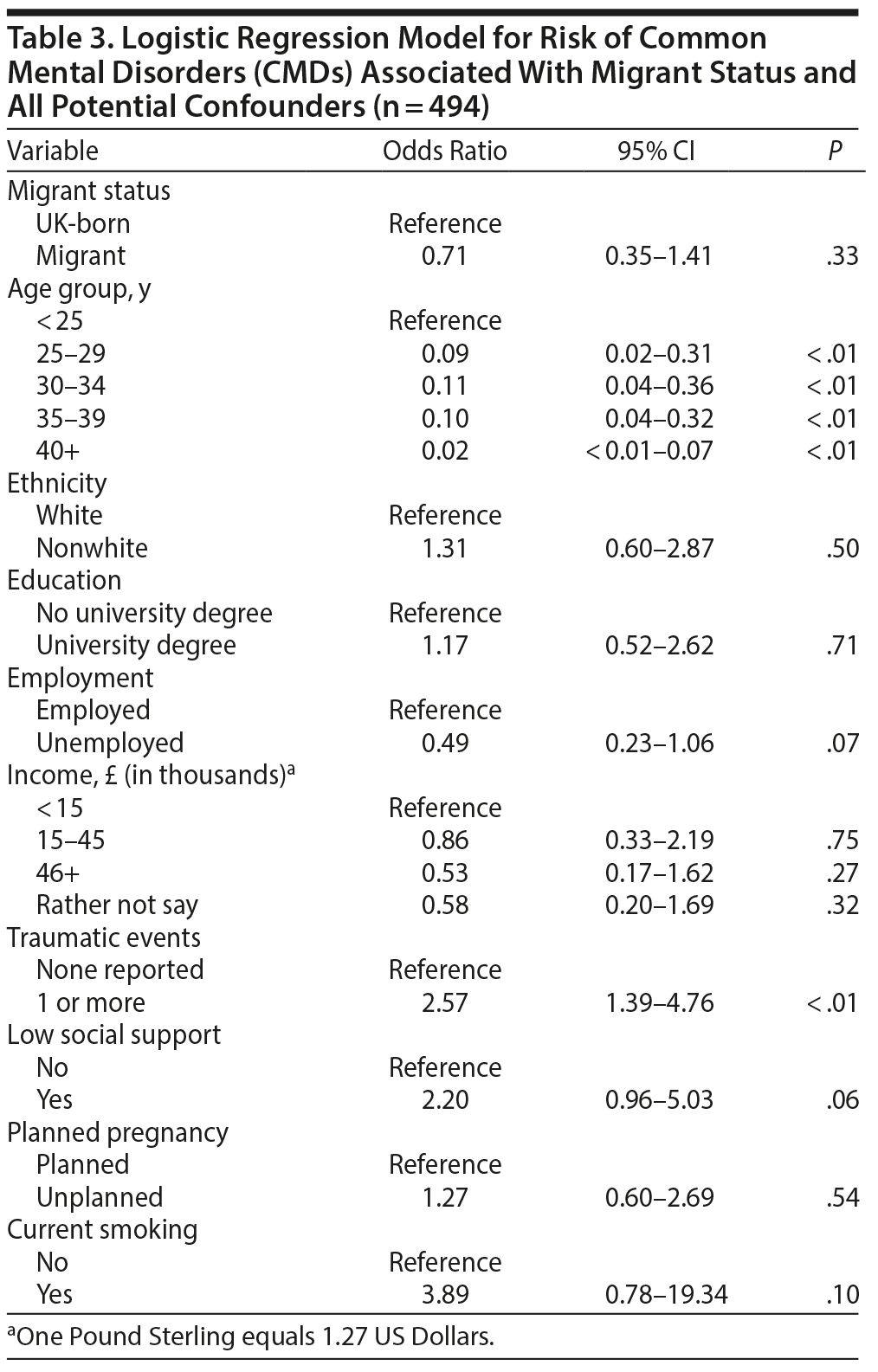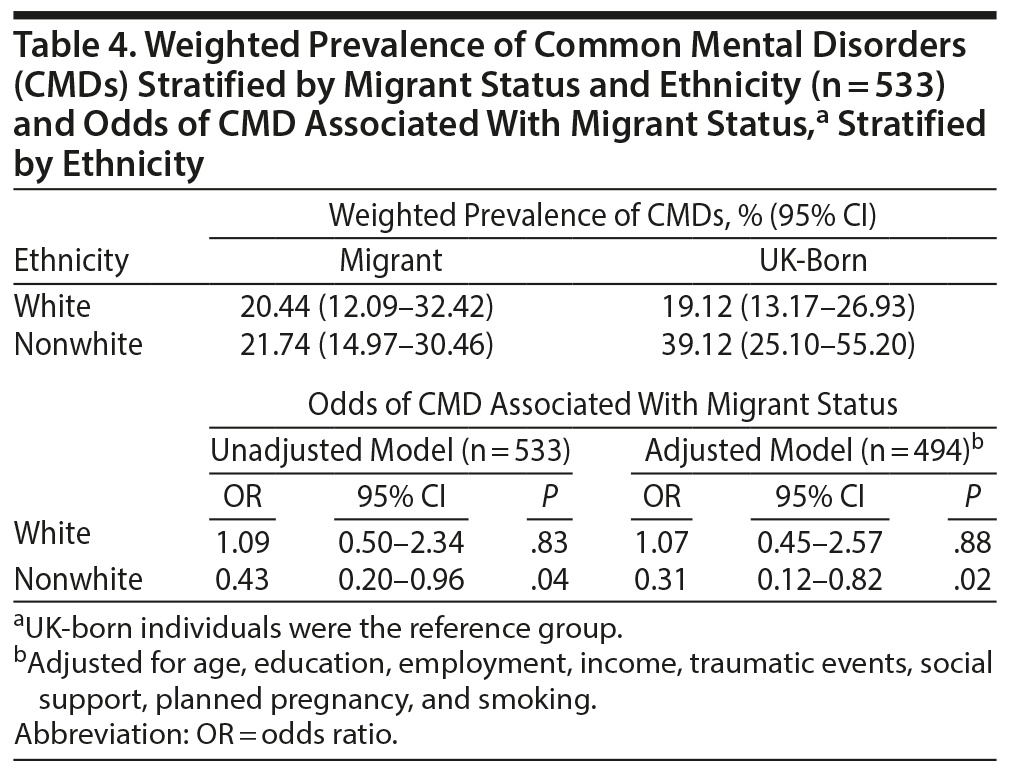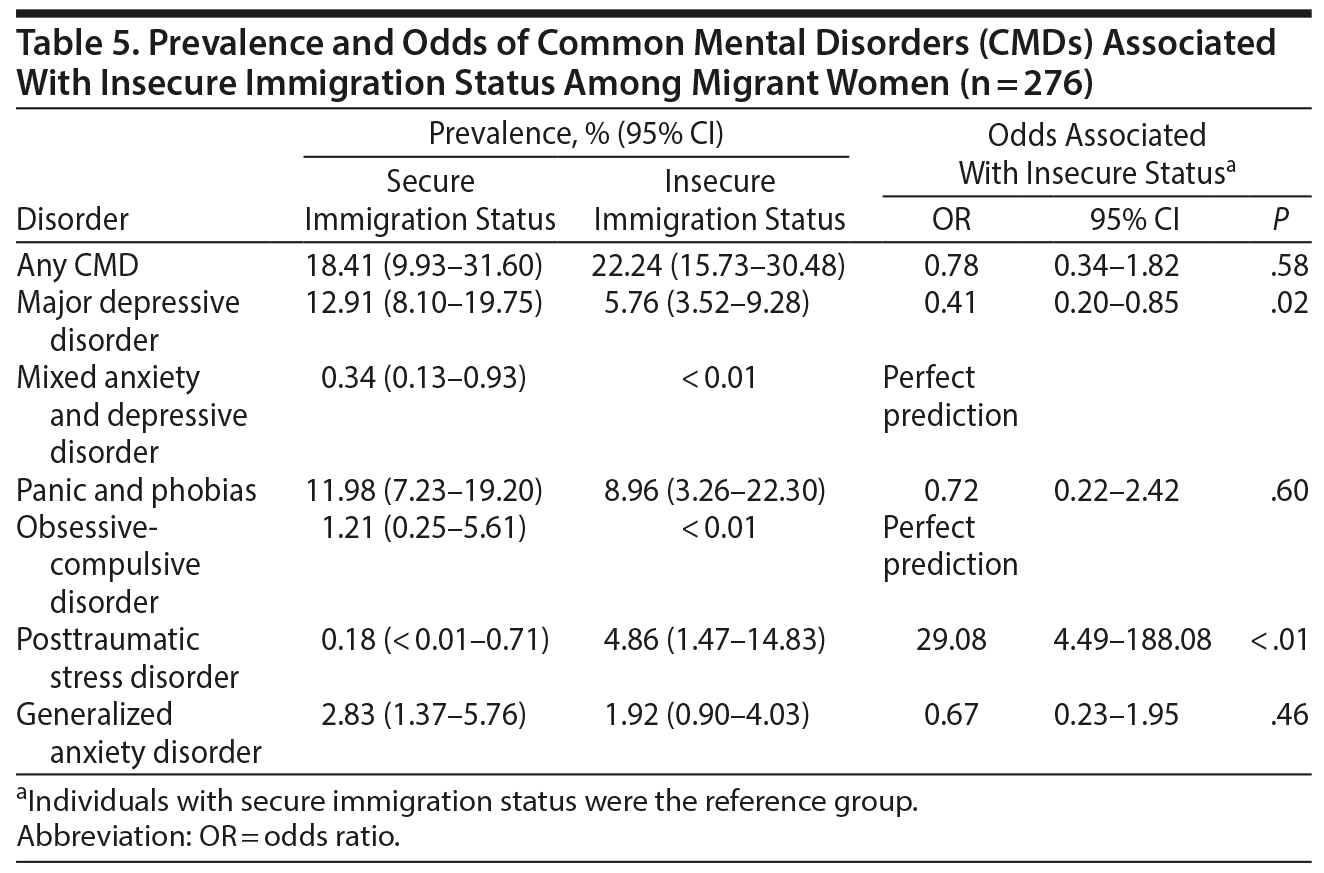Objective: There is limited evidence on the prevalence and odds of antenatal common mental disorders (CMDs) among migrant women and the effect on risk of intersecting variables such as immigration status and ethnicity. This study aimed to estimate the prevalence and odds of antenatal CMDs among migrant women compared to UK-born women in an inner-London maternity service.
Methods: A cross-sectional survey stratified by response to depression screening questions was administered at first antenatal appointment. CMDs were assessed using the Structured Clinical Interview for DSM-IV. Recruitment took place between November 2014 and June 2016.
Results: Prevalence of antenatal CMDs was 21% (95% CI, 16-28) among migrant women (n = 283) and 24% (95% CI, 18-31) among UK-born women (n = 262). There was no significant difference in the odds of CMDs among migrant women compared to UK-born women (OR = 0.86; P = .57; 95% CI, 0.51-1.44). Migrant women, particularly those with insecure immigration status, had increased odds of posttraumatic stress disorder (OR = 29.08; P < .01; 95% CI, 4-188). When analyses were stratified by ethnicity, there was no effect of migrant status for white women, but for ethnic minority (nonwhite) women, migrant status decreased odds of having a CMD (OR = 0.31; P = .02; 95% CI, 0.12-0.82).
Conclusions: Antenatal common mental disorders are prevalent among migrant women, but migrant status is unlikely to increase risk on its own. Immigration status, ethnicity, and other intersecting variables of social disadvantage must be investigated simultaneously to examine the perinatal mental health of heterogeneous migrant populations.
This work may not be copied, distributed, displayed, published, reproduced, transmitted, modified, posted, sold, licensed, or used for commercial purposes. By downloading this file, you are agreeing to the publisher’s Terms & Conditions.

ABSTRACT
Objective: There is limited evidence on the prevalence and odds of antenatal common mental disorders (CMDs) among migrant women and the effect on risk of intersecting variables such as immigration status and ethnicity. This study aimed to estimate the prevalence and odds of antenatal CMDs among migrant women compared to UK-born women in an inner-London maternity service.
Methods: A cross-sectional survey stratified by response to depression screening questions was administered at first antenatal appointment. CMDs were assessed using the Structured Clinical Interview for DSM-IV. Recruitment took place between November 2014 and June 2016.
Results: Prevalence of antenatal CMDs was 21% (95% CI, 16-28) among migrant women (n = 283) and 24% (95% CI, 18-31) among UK-born women (n = 262). There was no significant difference in the odds of CMDs among migrant women compared to UK-born women (OR = 0.86; P = .57; 95% CI, 0.51-1.44). Migrant women, particularly those with insecure immigration status, had increased odds of posttraumatic stress disorder (OR = 29.08; P < .01; 95% CI, 4-188). When analyses were stratified by ethnicity, there was no effect of migrant status for white women, but for ethnic minority (nonwhite) women, migrant status decreased odds of having a CMD (OR = 0.31; P = .02; 95% CI, 0.12-0.82).
Conclusions: Antenatal common mental disorders are prevalent among migrant women, but migrant status is unlikely to increase risk on its own. Immigration status, ethnicity, and other intersecting variables of social disadvantage must be investigated simultaneously to examine the perinatal mental health of heterogeneous migrant populations.
J Clin Psychiatry 2019;80(5):18m12563
To cite: Anderson FM, Hatch SL, Ryan EG, et al. Impact of insecure immigration status and ethnicity on antenatal mental health among migrant women. J Clin Psychiatry. 2019;80(5):18m12563.
To share: 10.4088/JCP.18m12563
© Copyright 2019 Physicians Postgraduate Press, Inc.
aSection of Women’s Mental Health, King’s College London, London, United Kingdom
bDepartment of Psychological Medicine, King’s College London, London, United Kingdom
cCancer Research UK Clinical Trials Unit (CRCTU), University of Birmingham, Birmingham, United Kingdom
*Corresponding author: Fraser M. Anderson, PhD,, Section of Women’s Mental Health, King’s College, De Crespigny Park, London, SE5 8AF United Kingdom ([email protected]).
Across the globe, people are moving from one country to another more than ever,1 and there is a growing need to examine the mental health of migrant populations. Mental disorders in the perinatal period are common2 and have adverse outcomes for both mother and infant.3 A systematic review and meta-analysis4 of the prevalence and odds of perinatal mental disorders found contradictory evidence as to whether migrant women are at increased risk, with some studies finding increased risk and others none or decreased risk, and the quality of methods was poor. Most research has focused on depression, ignoring other common mental disorders (CMDs) such as anxiety disorders including posttraumatic stress disorder (PTSD). Previous studies have used screening instruments rather than diagnostic measures of disorder. Screening measures using cutoff scores can give an indication of probable disorder or high symptom level but cannot constitute a diagnosis. Moreover, establishing the prevalence of clinical disorders is useful for planning of clinical services. Finally, many studies have substantial sample bias due to exclusions on the basis of language and the exclusion of hard-to-reach women such as asylum-seekers who may have no phone number or fixed address. This study, using data from the WEll-being in pregNancy stuDY (the WENDY study)5 in an inner city maternity service, was designed to address these gaps in the literature. The present study had the following aims:
- to estimate the prevalence and odds of antenatal CMDs among migrant women compared to UK-born women in an inner-London maternity service
- to examine whether the relationship between migrant status and odds of antenatal CMD varies by ethnicity, immigration status, and length of time in the United Kingdom.
Our primary hypothesis was that the prevalence of CMDs at antenatal booking appointment would be higher among migrant women than women born in the United Kingdom. We also aimed to carry out exploratory analyses to examine the relationship between individual CMDs (major depressive disorder, mixed anxiety and depressive disorder, panic disorder, agoraphobia [with and without panic disorder], social phobia, specific phobia, obsessive-compulsive disorder [OCD], PTSD, and generalized anxiety disorder [GAD]) and migrant status and the intersection with ethnicity, immigration status, and length of time in the United Kingdom.
METHODS
Study Setting and Design
The WENDY study5 was conducted at an inner-city London maternity service (7,000 births per year) with an ethnically and socially diverse population and around 50% of women born outside the United Kingdom. The dates of recruitment were November 10, 2014, to June 30, 2016. The study used a 2-phase sampling design drawing a random sample stratified according to being positive or negative on the Whooley depression screening questions6 asked by midwives at the first comprehensive antenatal booking appointment. This study focuses on the baseline interview data collected within 3 weeks of participants’ antenatal booking appointment.

- The impact of migrant status, ethnicity, and immigration security on risk of antenatal mental disorders is unclear. Disorders other than depression, such as posttraumatic stress disorder, have seldom been investigated, and few studies have used diagnostic measures.
- Common mental disorders are highly prevalent among migrant women during pregnancy; it is important to assess for posttraumatic stress disorder in this population.
Participants
All women aged 16 years or over who answered the Whooley questions at antenatal booking were eligible to take part. Women who lacked mental capacity to provide informed consent, women who had already undergone a comprehensive maternity booking in the United Kingdom, and women who had a termination or miscarriage between booking and baseline interview were excluded from the study. There were no exclusions on the basis of language, with telephone and face-to-face interpreters made available. All eligible women who screened positive from the Whooley questions were approached to take part, and all women who screened negative were randomized by the King’s Clinical Trials Unit as to whether or not to be approached (further details of this process are provided in the primary publication5). Several attempts to contact women were made, including evening and weekend calls and appointments, to minimize selection bias. Home visits were offered as well as covering of travel and childcare costs. Interviews were conducted either at the hospital or at the participant’s home and lasted around an hour. For asylum-seeking women staying in hostels, contact was made through the specialist migrant midwife in cases in which women had no access to a phone, and interviews were conducted at the hostel.
Measures
Sociodemographic information including migration information (region of birth, year arrived in the United Kingdom, current immigration status), and medical and obstetric history were collected at the baseline interview. We collected data on self-defined ethnicity using the UK census categories. For analyses, a binary variable of ethnicity was used, “white” (white English/Welsh/Scottish/Northern Irish/British; white Irish; Gypsy or Traveler; other white) and “nonwhite” (all other categories), to differentiate majority and minority ethnicity. Doing so was necessary due to the small number of women in groups other than white or black (see Table 1). A binary variable of secure or insecure immigration status was used in analyses, grouping UK nationals, European Economic Area citizens, and those with indefinite leave to remain into “secure immigration status” and all other statuses into “insecure immigration status.”

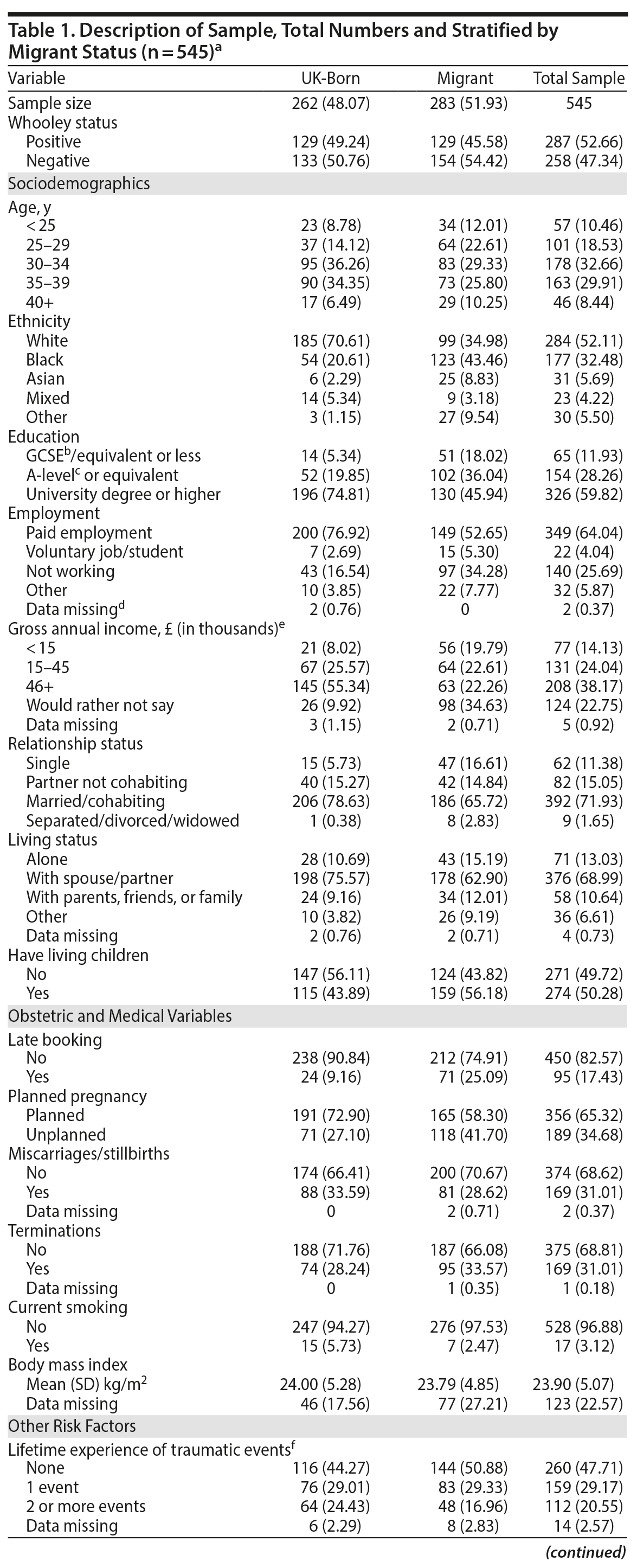
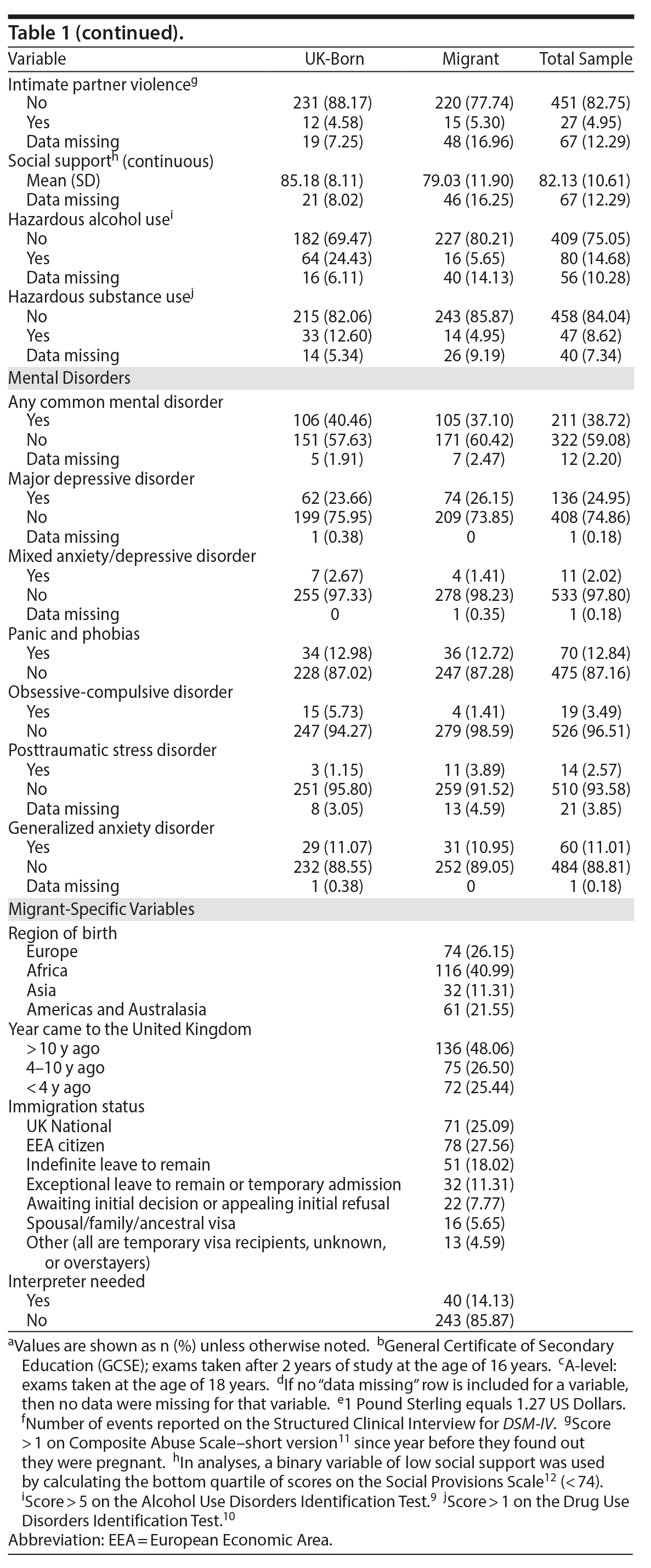
The primary outcome of diagnosis of a CMD was measured using the Structured Clinical Interview for DSM-IV Axis I Disorders (SCID-I),7 a semistructured gold-standard diagnostic interview used widely in psychiatric research.8 The SCID-I was used to identify the following mood and anxiety disorders: major depressive disorder, mixed anxiety and depressive disorder, panic disorder, agoraphobia (with and without panic disorder), social phobia, specific phobia, OCD, PTSD), and GAD.
All researchers on the project were postgraduates with either a psychology background or midwifery experience. Researchers were trained in using the SCID over a 3-month period and attended regular supervision with a perinatal psychiatrist to reach consensus on diagnoses. Other instruments used in this analysis and administered at baseline interview were the Alcohol Use Disorder Identification Test,9 the Drug Use Disorders Identification Test,10 the Composite Abuse Scale-short version,11 and the Social Provisions Scale.12 Validated versions of translated instruments were used when available; otherwise, instruments were translated by the face-to-face interpreters.
Ethics and Service-User Involvement
Ethical approval for the WENDY study was obtained from London Camberwell St. Giles National Health Service Research Ethics Committee (reference number: 14/LO/0075). Informed consent was obtained from all participants prior to interview. There was a Patient Advisory Group including women who had experienced mental health problems during the perinatal period and some of their partners. They provided input and feedback on aspects of study design, conduct, and progress and met regularly throughout the study.
Statistical Analysis
All statistical analyses were carried out using Stata 13.13 A significance level of P = .05 was used for all statistical tests unless otherwise specified. Descriptive statistics were used to summarize the characteristics of the total sample and then stratified by migrant status (migrant or UK-born). As the study oversampled women who screened positive for depression (Whooley-positive women) and undersampled those who screened negative for depression (Whooley-negative women), expansion weights were used when calculating population prevalence estimates and for all other statistical analyses. The weights were calculated as 906/287 for the Whooley positives and 9,057/258 for the Whooley negatives. Univariate associations of key variables with the exposure (migrant status) and the outcome (CMD) were conducted using χ2 tests.
The primary hypothesis of the study, that migrant woman would be at increased risk of CMD compared to UK-born women, was tested using logistic regression alongside weighted prevalence estimates with 95% confidence intervals for CMD stratified by migrant status. The unadjusted logistic regression model was run with presence of any CMD (yes/no) as the outcome variable and migrant status (migrant/UK-born) as the predictor variable.
We then conducted exploratory analyses to examine the association between migrant status and the different individual psychiatric diagnoses (major depressive disorder, mixed anxiety and depressive disorder, panic disorder, agoraphobia [with and without panic disorder], social phobia, specific phobia, OCD, PTSD, and GAD), adjusting for potential confounders. In addition, we conducted analyses to explore the intersection of migrant status with ethnicity, immigration status, and length of time in the United Kingdom and association with CMD.
When possible, scores on scales with missing data were imputed using the participant’s mean score on other subscales. Sensitivity analyses were conducted when appropriate to compare associations using all available data for that test, and a complete case analysis was done to assess the impact of missing data on biasing the results.
RESULTS
Description of Sample
A total of 545 women were recruited into the WENDY study baseline assessment; a flowchart of participants included in the study has been published.5 The women in the WENDY sample were representative of the hospital maternity population in terms of ethnicity, age, and the number of children they had. A description of the sample using unweighted frequencies and percentages is provided in Supplementary Table 1.
The sample consisted of 283 (51.93%) migrant women compared to 262 (48.07%) UK-born women. Comparing sociodemographic variables, migrant women were different in terms of ethnicity (fewer white women), less educated, and less likely to be in employment and had lower income than their UK-born counterparts. Migrant women were more likely to be late-bookers for antenatal care, and they were more likely to report their pregnancy as unplanned than their UK-born counterparts. Migrant women were also less likely than UK-born women to be current smokers or report hazardous alcohol or substance misuse. There were no differences between migrant and UK-born women in exposure to traumatic events or intimate partner violence. Migrant women were more likely to have social support scores in the lowest quartile than UK-born women.
Among the whole sample, prevalence of CMD was higher among younger women, women with low income, and single women. Women who reported their pregnancy as being unplanned, those currently smoking, those who reported traumatic events, and those reporting low social support all had higher prevalence of CMD. Immigration status was the only migrant-specific variable associated with CMD; continent of birth, length of time in the UK, and needing an interpreter were not associated with CMD.
The variables considered a priori to be potential confounders of the primary hypothesis were age, ethnicity, socioeconomic status (as indicated by education, employment, and income), experience of traumatic events, and social support. Additional confounders were identified as those variables (hypothesized to be potentially relevant from the literature review) associated with both the exposure (migrant status) and the outcome (CMD). The additional variables identified through these analyses were whether the pregnancy was planned and current smoking. These variables were therefore included in models as confounders alongside the a priori confounders. The primary hypothesis was that the prevalence of CMDs (depression, anxiety disorders, and PTSD) at antenatal booking appointment will be higher among migrant women than women born in the United Kingdom.
The weighted prevalence of CMDs (including PTSD) among migrant women was 21.26% (95% CI, 15.76%-28.04%) and 24.09% (95% CI, 18.14%-31.25%) among UK-born women (Table 2). There was no significant difference in the odds of having a CMD among migrant women compared to UK-born women (OR = 0.85; P = .54; 95% CI, 0.51-1.42). Thus, there was no evidence to support the primary hypothesis. When disaggregated by disorder (see Table 1), migrant women had increased odds of PTSD and decreased odds of GAD. There were no significant associations between migrant status and the other outcomes.
In the fully adjusted model (Table 3), younger age and experience of traumatic events were associated with increased odds of CMD. Low social support was marginally significant as a risk factor for CMD, and being unemployed was marginally significant as a protective factor.
Ethnicity and Migration
White migrants, white UK-born women, and nonwhite migrants all had similar prevalence of CMD (approximately 20%), while the nonwhite UK-born group had nearly double the weighted prevalence (39%) (see Table 4). When the groups were stratified by ethnicity, there was no significant difference between migrant and UK-born risk for CMD among white women. For nonwhite women, the risk of CMD was significantly lower in the migrant group, and the effect was stronger after adjustment for potential confounders (see Table 4).
Security of Immigration Status
There were no significant associations between security of immigration status and CMD in unadjusted or adjusted models. As with the main association, we examined whether the association between security of immigration status and CMD differed by diagnosis by stratifying the analyses by disorder (Table 5).
In this analysis stratifying the association by disorder, migrant women with insecure status were at greater risk of PTSD and at lower risk of MDD than migrant women with secure status (Table 5).
Length of Time in the United Kingdom
There were no significant differences in the prevalence or odds of CMD among migrant women who had been in the United Kingdom for differing lengths of time. However, the overall trend appeared to be increasing prevalence and odds of CMD with increasing time in the United Kingdom. Again, the largest difference in prevalence was between the white and nonwhite women born in the United Kingdom, with the ethnic minority women reporting around twice the prevalence of CMD.
Missing Data
We ran a sensitivity analysis, running the main unadjusted logistic regression model with only the complete cases (n = 494), and the results were very similar to those of the unadjusted model including all those with complete data on outcome and exposure (n = 533). The main association including only complete cases (OR = 0.85; 95% CI. 0.49-1.42; P = .51) was very similar to that found from the larger model (OR = 0.86; 95% CI. 0.51-1.44; P = .57). This finding suggests that the effect of missing data on changing the associations was minimal.
DISCUSSION
Summary of Results
This study found that CMDs were highly prevalent in early pregnancy among both migrant and UK-born women. However, there was no overall increased risk of antenatal CMDs among migrant women compared to UK-born women, despite the migrant group’s being significantly more exposed to risk factors for CMD—minority ethnicity, lower educational level, being unemployed, lower income, more unplanned pregnancy, and lower social support. In addition, the odds of PTSD were significantly higher in the migrant group, while odds of GAD were significantly lower than for the UK-born women. Similarly, there was no overall increased risk of CMD associated with insecure immigration status, but the migrant women with insecure immigration status had significantly increased odds of PTSD and significantly decreased odds of depression compared to migrant women with secure immigration status. After stratification by ethnicity, among white women there was no overall effect of migrant status on risk for CMD; however, among nonwhite women, migrant status lowered the odds of CMD, and the protective effect of migrant status was strengthened after adjustment for confounders. Again, there was no significant effect of length of time in the United Kingdom on risk for CMD, although the trend in the sample was that increased time in the United Kingdom increased the risk of CMD.
Comparison With Previous Literature
The prevalence estimates of depression, anxiety, and PTSD were lower than those found in previous studies,4 very likely reflecting the difference between symptom screening measures and a diagnostic measure of disorder. The finding of no increased risk of CMD associated with migrant status is supported by the inconclusive evidence found in studies examining symptoms of depression in the perinatal period4 and may reflect the “healthy migrant effect” observed in other areas of health.14 The increased odds of PTSD among migrant women, in particular those with insecure status, is supported by a previous study15 that investigated PTSD symptoms among immigrants, refugees, and asylum-seekers in Canada. Although the migrant women in our study were at increased risk of PTSD, they were not significantly more likely to have experienced traumatic events in their lifetime than their UK-born counterparts. However, the timing and the nature or severity of traumatic events were not investigated, and it is plausible that differences in these could account for this discrepancy. Previous research16 into PTSD in asylum-seekers found that although those with PTSD symptoms did report significantly more trauma events compared to those without, those with PTSD symptoms also reported more stress in relation to post-migratory factors relevant to the asylum-seeking process. This finding was suggested to be because ongoing PTSD symptoms may be exacerbated by such stressors.16 A systematic review of pre-displacement and post-displacement factors affecting the mental health of refugees and asylum-seekers found that the post-displacement conditions were more predictive of health outcome than the pre-displacement factors.17 This finding may help explain the increased risk of PTSD among migrant women with insecure status despite the absence of increased exposure to lifetime traumatic events in this study.
Our results support the growing consensus that ethnicity and migrant status must be considered simultaneously as intersecting social categories impacting on health, as important differences emerged when the analyses were stratified. Evidence from the Millennium Cohort Study (MCS)18 in the United Kingdom investigating postnatal depression found similar findings to those of the present study. The MCS found that mothers born abroad were less likely to be depressed than UK-born mothers, whereas mothers in the other white, Indian, and Pakistani ethnic groups were more likely to be depressed than white British/Irish mothers irrespective of country of birth and demographic and socioeconomic differences.18 The results from this study did not find length of time in the United Kingdom to be a statistically significant risk factor, aside from the most recent ethnic minority migrants being at decreased risk of CMD compared to ethnic minority UK-born women. However, the trend was toward increasing risk with length of time in the United Kingdom, particularly among ethnic minority women. One explanation for the deterioration of migrant health is that of increased exposure to minority status and the increase in stressors that entails, such as discrimination and relative social disadvantage.19 This increased exposure would help to explain the findings of an overall protective effect of migrant status on the mental health of ethnic minority women.
Strengths and Limitations
The most important and novel strength of this study was that we used a diagnostic instrument rather than a screening tool to identify CMDs during pregnancy. This study is one of the first to do so. This difference means that, unlike in previous studies, the prevalence estimates presented are the estimates for disorder rather than high symptoms or “probable” disorder. The differentiation between disorder and high symptom level is important both for furthering our understanding of the epidemiology of mental disorders and also for the planning of services, as meeting criteria for disorder is usually the cutoff for receiving treatment. It was also a strength that we identified disorders other than depression, including PTSD, which have been underresearched in the perinatal period. The very diverse sample is another strength of this study. Our lack of restrictions on the languages women could speak to take part in the study, and our focused efforts on recruiting hard-to-reach groups of women such as asylum-seekers, means that the diversity of the population was reflected in the study.
The study was cross-sectional in design, meaning that causal effects and potential mediating variables could not be investigated. However, for clinical practice, the causal implications of the independent effect of migration on mental health are less relevant than knowing which groups are at risk. Although the diverse sample was a great strength of the study, the population of women is quite unique to London and therefore may not be generalizable to more rural areas or countries with different immigration patterns. Furthermore, although efforts were made to reduce selection bias, it is probable that women with mental health problems and women with insecure immigration status were less likely to take part in research, which may have biased the findings. Finally, although the sample size was very large for an epidemiologic study using a diagnostic instrument, it was not sufficiently powered to fully explore the heterogeneity of disorder (eg, the differential diagnoses) or the heterogeneity of the population (eg, simultaneous modeling of ethnicity, social class, immigration status, length of time in the United Kingdom).
Implications
For clinicians, particularly in maternity services, it is important to be aware of the high prevalence of antenatal CMDs for all women. The increased prevalence among ethnic minority women born in the United Kingdom is important for clinicians to be aware of and needs to be investigated further. Future research should focus on elucidating the mechanisms by which minority ethnicity, migration, and other social inequalities impact on mental health in the pursuit of guiding interventions and services that meet the needs of diverse populations of women.
CONCLUSIONS
Common mental disorders in early pregnancy are highly prevalent, for both migrant women and women born in the United Kingdom. Migrant women may be at increased risk of PTSD, in particular those migrant women with insecure immigration status. Ethnicity and migrant status must be considered simultaneously, as the effect of migrant status on mental health may differ by ethnic group. Results from stratified analyses and examination of length of time in the United Kingdom suggest a deleterious effect of living in the United Kingdom on the mental health of ethnic minorities, with migration serving as a protective factor for this group. Future research using an intersectional approach to elucidate the effect of multiple axes of disadvantage, including migration, on the mental health of perinatal populations is needed to investigate these findings further.
Submitted: September 6, 2018; accepted March 18, 2019.
Published online: July 30, 2019.
Potential conflicts of interest: Dr Howard chaired the National Institute for Health and Care Excellence CG192 guidelines development group on antenatal and postnatal mental health in 2012-2014. Drs Anderson, Hatch, Ryan, and Trevillion have no declarations of interest.
Funding/support: This article summarizes independent research funded by the National Institute for Health Research (NIHR) under the Programme Grants for Applied Research programme (ESMI Programme: grant reference number RP-PG-1210-12002) and the NIHR/Wellcome Trust Kings Clinical Research Facility and the NIHR Biomedical Research Centre at South London and Maudsley National Health Service (NHS) Foundation Trust and Kings College London. Dr Howard is also supported by an NIHR Research Professorship (NIHR-RP-R32-011).
Role of the sponsors: The providers of support had no role in the conduct and publication of the study.
Disclaimer: The views expressed are those of the authors and not necessarily those of the NHS, the NIHR, or the Department of Health and Social Care. The study team acknowledges the study delivery support given by the South London Clinical Research Network.
Supplementary material: See accompanying pages.
REFERENCES
1.United Nations. Trends in International Migration Stock: The 2015 Revision. United Nations, Department of Economic and Social Affairs, Population Division. United Nations database, POP/DB/MIG/Stock/Rev.2015. https://www.un.org/en/development/desa/population/migration/data/estimates2/
docs/MigrationStockDocumentation_2015.pdf.
2.Vesga-López O, Blanco C, Keyes K, et al. Psychiatric disorders in pregnant and postpartum women in the United States. Arch Gen Psychiatry. 2008;65(7):805-815. PubMed CrossRef
3.Stein A, Pearson RM, Goodman SH, et al. Effects of perinatal mental disorders on the fetus and child. Lancet. 2014;384(9956):1800-1819. PubMed CrossRef
4.Anderson FM, Hatch SL, Comacchio C, et al. Prevalence and risk of mental disorders in the perinatal period among migrant women: a systematic review and meta-analysis. Arch Women Ment Health. 2017;20(3):449-462. PubMed CrossRef
5.Howard LM, Ryan EG, Trevillion K, et al. Accuracy of the Whooley questions and the Edinburgh Postnatal Depression Scale in identifying depression and other mental disorders in early pregnancy. Br J Psychiatry. 2018;212(1):50-56. PubMed CrossRef
6.Whooley MA, Avins AL, Miranda J, et al. Case-finding instruments for depression: two questions are as good as many. J Gen Intern Med. 1997;12(7):439-445. PubMed CrossRef
7.First M, Spitzer R, Gibbon M, et al. Structured Clinical Interview for DSM-IV Axis I Disorders (SCID-I). Clinician Version, Administration Booklet. Arlington, VA: American Psychiatric Publishing; 2012.
8.Williams JB, Gibbon M, First MB, et al. The structured clinical interview for DSM-III-R (SCID), II: multisite test-retest reliability. Arch Gen Psychiatry. 1992;49(8):630-636. PubMed CrossRef
9.Babor F, Higgins-Biddle JC, Saunders JB, et al. AUDIT – The Alcohol Use Disorders Identification Test: Guidelines for Use in Primary Care. Geneva, Switzerland: The World Health Orginisation; 2008.
10.Berman AH, Bergman H, Palmstierna T, et al. DUDIT – The Drug use Disorder Identification Test. Stockholm, Sweden: Department of Clinical Neuroscience, Karolinska Institutet ; 2003.
11.Hegarty K, Sheehan M, Schonfeld C. A multidimensional definition of partner abuse: development and preliminary validation of the Composite Abuse Scale. J Fam Violence. 1999;14(4):399-415. CrossRef
12.Cutrona C, Russell D. The provisions of social relationships and adaptation to stress. In: Joles WH, Perlman D, eds. Advances in Personal Relationships Greenwich, CT: JAP Press; 1987.
13.StataCorp. Stata: Release 13. Statistical Software. College Station, TX: StataCorp LP; 2013.
14.Argeseanu Cunningham S, Ruben JD, Narayan KMV. Health of foreign-born people in the United States: a review. Health Place. 2008;14(4):623-635. PubMed CrossRef
15.Gagnon AJ, Dougherty G, Wahoush O, et al. International migration to Canada: the post-birth health of mothers and infants by immigration class. Soc Sci Med. 2013;76(1):197-207. PubMed CrossRef
16.Silove D, Sinnerbrink I, Field A, et al. Anxiety, depression and PTSD in asylum-seekers: associations with pre-migration trauma and post-migration stressors. Br J Psychiatry. 1997;170(4):351-357. PubMed CrossRef
17.Porter M, Haslam N. Predisplacement and postdisplacement factors associated with mental health of refugees and internally displaced persons: a meta-analysis. JAMA. 2005;294(5):602-612. PubMed CrossRef
18.Jayaweera H, Quigley MA. Health status, health behaviour and healthcare use among migrants in the UK: evidence from mothers in the Millennium Cohort Study. Soc Sci Med. 2010;71(5):1002-1010. PubMed CrossRef
19.Williams DR, Mohammed SA. Discrimination and racial disparities in health: evidence and needed research. J Behav Med. 2009;32(1):20-47. PubMed CrossRef
Editor’s Note: We encourage authors to submit papers for consideration as a part of our Focus on Women’s Mental Health section. Please contact Marlene P. Freeman, MD, at [email protected].
This PDF is free for all visitors!
